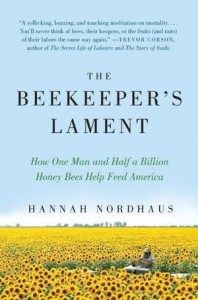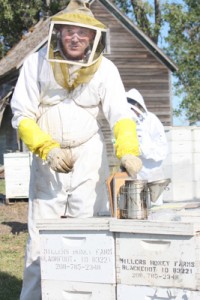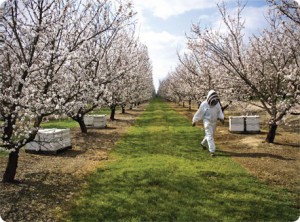 A new book coming out this month offers a unique look at the life of commercial beekeepers and the current state of commercial beekeeping in the U.S. The Beekeeper’s Lament: How One Man and Half-a-Billion Honey Bees Help Feed America by Hannah Nordhaus follows John Miller, one of only 1200 commercial beekeepers still crossing the country each year to pollinate the crops of America’s farms.
A new book coming out this month offers a unique look at the life of commercial beekeepers and the current state of commercial beekeeping in the U.S. The Beekeeper’s Lament: How One Man and Half-a-Billion Honey Bees Help Feed America by Hannah Nordhaus follows John Miller, one of only 1200 commercial beekeepers still crossing the country each year to pollinate the crops of America’s farms.
Many people don’t realize how big a factor honey bees are to the amount and variety of food available in our farmer’s markets and grocery stores. Commercial beekeepers like Miller give up a significant portion of each year traveling from farm to farm with their hives, helping to boost each harvest by using their bees to pollinate the fields. More than 90 crops use honey bees for pollination and each year the bees help provide almost a third of the nation’s crop equating to over $15 billion worth of food. Without honey bees, many crops would only produce a fraction of the harvest the bees make possible.

John Miller
While honey bees are critical to crop pollination, the work they do to boost the bounty of our farms is only a by-product of their actual job, making honey. One colony can produce 30 pounds of honey in a day, which is incredible considering it takes about 55,000 bee miles and 2 million flowers to produce just one of those pounds. Commercial beekeepers, like Miller, make the pollination and the honey possible.
Sadly, unpredictable financial results paired with the physical and emotional toll of spending 8 out of 12 months away from home and family has driven commercial beekeepers out of the profession at an alarming rate. In the past 15 years alone, Miller estimates the number of active beekeepers providing commercial services has dropped from over 5,000 to barely 1,200.
In addition to the loss of beekeepers, the commercial honey bee industry is facing a devastating loss of hives. Since 2006, one third of the nation’s commercial honey bee population, about a million bees a year, has been lost to Colony Collapse Disorder. The cause of the disorder continues to elude researchers who have considered environmental variables, weather, food supply, and other factors as possible causes. Miller believes the colony collapse is a result of a combination of factors. In the book, he explains his theory to Nordhaus.
“I still go back to the death-by-a-thousand-paper-cuts theory,” says Miller. “That it’s some combination of stress, pathogens, chemical materials, overstimulation, near starvation-an accumulation of what we do.”
Without dramatizing the situation or understating the critical nature of the problem, the Beekeeper’s Lament paints a moving picture of dedicated beekeepers that are passionate about the work they do and the bees they work with. By using the real-life experiences and problems of those dedicated to tending the nation’s bees, Nordhaus illustrates the true importance of the bees and their keepers to the farms of America and the people they feed.
Related Articles:
- The Secret to Looking Good & Feeling Good (fillyourplate.org)
- Buzz Worthy by Hannah Nordhaus (spiritmag.com)
- Hannah Nordhaus: Beekeeper’s Lament (hannahnordhaus.com)




Pingback: Focus on Agriculture: Cutting Farm Programs Would be a Pyrrhic Victory | Fill Your Plate Blog
Pingback: Reversing the Obesity Trend | Fill Your Plate Blog